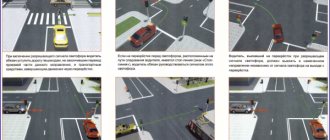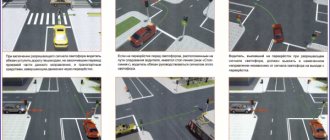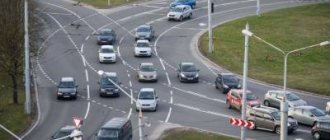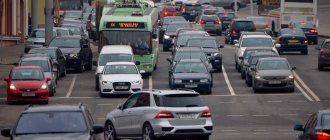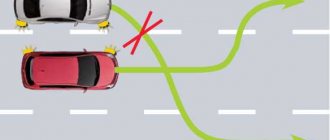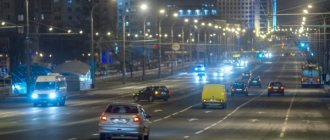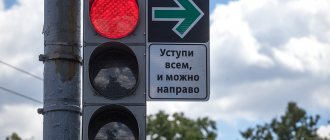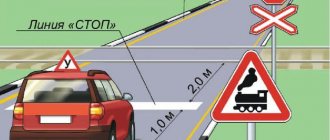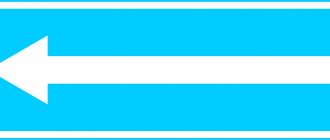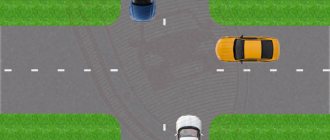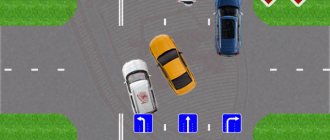Precautionary measures. Traffic rules and travel within the intersection
Approaching such intersections is recommended at a lower speed than constant - depending on the landscape, road and weather factors.
It is important not to forget the fact that any road intersection, even the most harmless one, is an area of increased risk of an accident. A clean asphalt surface can become contaminated as a result of adverse weather conditions and many other factors (oil film, for example)
Vigilance and careful attention to signs and road markings will protect you from force majeure at any (not only T-shaped) intersections - be it a suddenly appearing car, a forest animal or livestock.
How to get through an uncontrolled T-junction
Rules for driving through unregulated intersections
Like any other intersection, the type under consideration is divided into two types: unequal and equivalent T-shaped intersection.
An equivalent intersection is not subject to any signage. All vehicles moving along it must necessarily give way to those vehicles moving on the right. In addition, when turning left at an equivalent intersection, the driver is obliged to give way to all cars moving straight in the opposite direction.
A T-shaped intersection of lanes is considered unequal if there is a sign in front of it. An intersection with such a sign must have a main and secondary road. Any driver knows that cars driving on a secondary road are required to give priority to those driving in the main direction. As with an equivalent intersection, drivers who choose to turn left are required to give priority to all vehicles traveling straight ahead in the oncoming lane.
There is another rule for driving through an equivalent intersection. If a driver turns off the main road, he has priority over other cars that are in the secondary lane.
T-intersection and equivalent roads
Today we will talk about driving through a T-shaped intersection of equivalent roads. Why? It's simple.
Traffic lights are installed at controlled intersections. Or there may be priority signs, which is important for an unequal intersection. In such situations, the order of travel will not raise any questions. That is, you need to go on green. And if you are moving along the main road, then cars from the secondary road must give way. And vice versa.
But it happens that there is a T-shaped intersection of equivalent roads. That is, there are no priority signs here. Therefore, it is unequal.
Here drivers should start from paragraphs 13.11 and 13.12.
In the first case, the driver undertakes to give way to vehicles approaching him from the right.
The second paragraph stipulates that when making a left turn or a U-turn, the driver must yield to cars that are moving along an equivalent road from the oncoming lane straight or to the right.
Everything is simple here. You need to rely on the rule that determines interference on the right.
If there are no priority signs, and the roads at the T-intersection are of equal quality, then you do not need to focus on how wide your section of the road is. For example, at intersections one road may be 4-lane, and the other 2-lane. And here many are sure that the 4-way is the main one.
But let us remember again that we are talking about an equivalent intersection. Therefore, if a car is moving on a 4-lane road, and at the same time a vehicle from a 2-lane lane exits and turns right, then the first car must allow the one performing the maneuver to pass. After all, the right interference rule applies here.
Again, a nuance. It is important to make sure that the car on the left allows you to pass. It is clear that in the event of an accident, the one who did not comply with the rule of interference on the right will be to blame. But this fact is unlikely to greatly please the other driver if the consequences of a collision are serious.
Rules for driving from a one-way track
Rules for turning around tram tracks outside an intersection
In the event of a change in the trajectory of the priority road, at an unregulated T-intersection there must be a plate 8.13, installed together with the road signs under paragraphs 2.1 and 2.4. You must immediately determine what the road is along which you approached the intersection and whether you have the right of way. First, vehicles that approached it along the priority route pass through the unregulated intersection.
T-junctions, mostly unregulated, outside populated areas are a common occurrence. Drivers (who have priority) will be aware of their approach to it by the signs under paragraphs 2.3.2 to 2.3.7, which means an adjacent secondary road,” while on the minor roads before the intersection of roads there are signs under paragraph 2.4, which means “ Give way”, under paragraph 2.5 - which means prohibition of movement without first stopping. Taking into account the high speeds of vehicles outside populated areas, travel from a secondary route to such an intersection requires extreme concentration of attention, because vehicles that have priority in traffic move at a higher speed than one can imagine.
Rules for driving on one-way roads
A similar intersection occurs in the case of a one-way flow along a rod, which at a T-intersection turns into a two-way roadway (not a rod). Often this is a T-intersection of unequal paths. The exit to such a road (two-way, not a core) is indicated by signs under paragraph 2.4, which means “Give way”, or under paragraph 2.5, which means starting to move without first stopping under a ban. When approaching this intersection, you must prematurely take the required lane according to the future traffic trajectory: right turn - the far right lane of the road, left turn - the far left lane. Travel further is possible only if traffic safety is taken into account and vehicles moving along the priority route are allowed to pass.
Locality
Rules for driving through intersections. Driving through controlled intersections
In the traffic rules there are no concepts of “city”, “village”, “metropolis” or “country”. There are sections of roads designated as “populated area” or “outside the populated area.” And these areas are indicated by corresponding signs.
Consequently, in Russian traffic practice there are three main sections of the road: a populated area, outside a populated area and a highway.
. Such areas differ in the requirements that are imposed on drivers moving along them. And the main requirement is maximum speed.
But, returning to the concept of a settlement, one should ask the question: “Why are there three signs indicating this area?” For one concept – three signs at once? Let's figure it out.
“Settled area” signs - black on white - mean that on this section of the road there are rules governing traffic in a populated area. Let’s call such a site a “real populated area.” That is, the general maximum speed limit here is no more than 60 km/h.
The second type of sign “Settled area” - white on blue - indicates a section of the road where traffic rules outside a populated area apply. In other words, the maximum speed here is classically limited - no more than 90 km/h (for vehicles of category B). As it should be outside the populated area!
A reasonable question arises: “Why is the last sign needed?” Or this: “Why call a site a populated area if it is not one?”
And it exists to inform the driver that he is passing by this very populated area, but has not yet entered it (and may not enter it until he encounters a “Settled Area” sign on his way - black on white!). But even here elements of the infrastructure of a settlement can be concentrated: bus stops, an abundance of intersections, pedestrian crossings, tram tracks, etc. But this is not a populated area!
Of course, such a mixture of concepts and signs is an absolute confusion. But these are our traffic rules that we must follow and comply with. Unfortunately, there are no others!
T-junction rules
- Adjustable. Driving through an intersection where the order of passage is regulated, as a rule, does not cause any difficulties. If the roadway consists of several traffic lanes and is equipped with a marking line (according to clause 1.18 of the traffic rules), and is also equipped with signs regulating the direction of travel along the lanes (clause 5.15.2 of the traffic rules), then you must follow them. In any case, in advance, before starting the maneuver, the driver must change lanes to the appropriate lane. Start driving only when the traffic light (or traffic controller) gives permission. If the traffic light has an additional section with an arrow, then when the indicator is activated in green, together with the main red traffic light signal, before moving, other vehicles should be given priority in moving (that is, you can move if this does not interfere with other road users ).
- Unregulated. Depending on the presence or absence of priority signs (road signs 2.1, 2.3.2-2.3.7, 2.4), an intersection can be formed by the intersection of equivalent and unequal roads. If the intersection is made up of unequal roads, when performing maneuvers you should be guided by signs that give priority when moving. A vehicle moving on a secondary road must give way to all vehicles moving on the main road. When changing the direction of the main road, both vehicle drivers on it must allow all traffic participants moving on the right side of it to pass, that is, such an intersection is passed by analogy with an intersection formed by the intersection of equivalent roads. If signs giving priority are not identified, then you should move along such an intersection according to the rules for equivalent roads.
- If the intersection is equal, then the driver is obliged to give priority to those vehicles moving to the right of him. When making a left turn or a U-turn, you must also give way to those vehicles located in the oncoming lane of the driver performing the maneuver.
If the order of passage through an intersection is regulated (by a traffic light or a traffic controller), this kind of intersection is called controlled. If there is no adjustment, it is called unregulated. Also, depending on the signs that give priority when driving, intersections can be equivalent or unequal. Let's consider the order of passage of different types of intersections.
Driving through unregulated intersections - saving your life and your car
The rules for driving through unregulated intersections do not represent anything supernatural, however, due to the fact that in the mentioned places there are no traffic lights, and everything depends only on the correct decision of the driver, there is a high probability of getting into an accident due to inattention. So be sure to follow both road markings and signs. At the same time, keep in mind that it is better to let even the worst offender pass, because not only your car and wasted nerves are at stake, but also your health, and even your life in general.
To correctly assess the situation, you need to provide yourself with maximum visibility; this is not so difficult to do, you just need to approach the intersection. True, in some cases trees, bushes, advertising and other objects can become an obstacle, but road services must monitor them. Then the car moves around based on priorities: drivers moving on the main road go first, and then on secondary roads. Moreover, the latter diverge from each other, using the rule of interference on the right, i.e. those cars that do not have it go first. The situation is also resolved at an uncontrolled intersection, where all roads are of equal importance.
In addition, we should not forget about such elementary, but at the same time mandatory things, on which our safety directly depends while traveling by car . Firstly, at a distance of at least fifty meters before the turn, we turn on the appropriate light signal in order to warn absolutely all participants about the maneuver. Secondly, we press as much as possible in the direction where we plan to turn. Thirdly, we do not cross the stop line markings and allow pedestrians to calmly pass through the crossing without blocking it with their vehicle.
The intersection does not always have 4 directions; the T-shaped type has only 3 roads. It's a little easier to drive through as you need to control fewer sides. If you leave a secondary road, you give way to everyone on the main road - both on the right and on the left. If you turn from the main one to the secondary one, then you simply miss the flow that is moving towards you. But a roundabout can slightly confuse the usual understanding of priority. Even when you are driving on a big wide road, but approaching a circle, you become secondary, unless otherwise indicated by signs, however, in the absence of traffic lights, this does not happen on the roads.
Having entered a circle, you become the boss, but if there are several lanes on it, change lanes very carefully, because due to the curvature of the trajectory, the side mirrors do not show all the vehicles next to you, and do not forget about the law of “interference on the right.”
Adjacent territory
In addition to the roads themselves, the road transport network of the Russian Federation also includes a number of sections along which traffic occurs, but which, according to traffic regulations, are not roads. We are talking about the surrounding area.
By definition, the adjacent area is adjacent (or adjacent) to the road. And therefore she herself is not considered such. This, of course, is a controversial statement, but it follows from the very letter of the Rules.
The adjacent territory includes areas where through traffic is prohibited:
1) gas stations;
2) courtyard areas;
3) parking places for vehicles;
4) territories of enterprises, institutions, etc.
Unfortunately, it is very problematic to accurately determine the exit from the adjacent territory. And this question is fundamental. The fact is that such exits are not considered intersections. The term “intersection” can be applied to them, but not “intersection of roadways” (or intersection).
And the principle of the question is as follows. For example, the nine most odious (including signs prohibiting overtaking, stopping, parking, limiting the maximum speed, etc.) are canceled by the intersection closest to the direction of travel.
Therefore, a driver who recognizes himself and mistakes the exit from the adjacent territory as an intersection risks violating the Rules and being punished for violating the requirements of these signs. In the future, a fine or even deprivation of your driver's license!
That is why you need to sacredly remember the rule: leaving the adjacent territory (or entering it) is not an intersection!
Rules for driving at controlled intersections
The rules for driving through intersections with traffic lights are regulated by the traffic lights (which are the main ones) and the signals of additional sections.
Vehicles moving on the main green traffic light must determine priority among themselves in accordance with the “interference on the right” rule. Let's say you're turning left at a crossroads, and an oncoming car is moving straight ahead. When the green light turns on, you must enter the intersection, starting the maneuver, and let the oncoming car pass, and only then complete the turn.
If the red or yellow signals and the additional section of the traffic light are on at the same time, first let through all vehicles for which the main green signal is on, and only then move in the direction indicated by the signal of the additional section.
Video lesson: driving through intersections according to the rules.
Traffic rules definitions: uncontrolled intersection and road priority
Before talking about the rules, it is worth clearly understanding some terms. To understand what intersections and roads we are talking about, you don’t have to be a genius, since everything is clear even from the names themselves. For example, at an unregulated intersection there are no means that forcefully determine the order of travel (a working traffic light or a person in a cap). Drivers are then forced to decide for themselves whether to start moving first or to let other vehicles pass, guided only by the rules and priority signs, if, of course, there are any.
The next term that is worth paying attention to is uneven roads. In this case, too, everything is simple, and we are talking about the intersection of a secondary direction and a main one, which has an advantage due to the priority signs located on it. In addition, the quality of the road surface is very important, since of two roads that do not have any priority signs, a traffic controller and a traffic light, the one with the better material will be considered the main one. For example, one is paved, but the second is not, the first will be more important. When they talk about roads of equal importance, it is understood that it is impossible to determine priority (there are no signs, the coverage is the same), and then the outcome of actions follows the rule of interference on the right.
Crossroads
The intersection seems to be an incredibly complex and important section of the road. No matter how the driver tries to avoid meeting him, it will not work. This is where the paths of vehicles and pedestrians intersect. This is where they “work” as much as possible: someone takes advantage, and someone must give way.
Let's try to understand the intricacies of this definition and the concept of “crossroads” in general.
1. An intersection is a section formed by the intersection (junction, branching) of roads in the same plane.
From this we conclude that driving under a bridge, overpass or overpass will not be considered an intersection.
The intersection of roads must be real - at the same level (or - it would be more correct to say - in the same plane).
2. From the definition proposed in the traffic rules, it is very difficult to imagine the structure of the intersection. But if you look at it in detail, the intersection is not only the intersection of roadways; it is wider and begins at the corners of curbs or shoulders.
3. The question of the types of intersections is fundamental. After all, there are a huge number of them:
a) classic four-digit (or “cruciform”) intersection;
b) an intersection without one side passage (T-shaped intersection);
c) three-digit Y-intersection.
An intersection can also have a rather complex architecture, where you can encounter not just one intersection of roadways, but 2 or more.
At the intersection shown in the figure above, there are two roadways crossing each other. And this question will be fundamental when studying road signs. There are simply signs (for example, prescriptive 4.1-4.6) that act precisely at the intersection in front of which the sign is installed.
And there are signs that can apply to the entire intersection (for example, “Main Road”).
Therefore, the number of roadway crossings is an important indicator of an intersection.
Another complex intersection with a roundabout has a special status.
The rules for its passage are a separate matter.
The driver’s task is to clearly know the rules for driving through any intersection that he encounters on his way. And we will definitely be faced with this problem in the future.
And one last thing. According to traffic regulations, exits from adjacent territories (and, consequently, entrances to them) are not intersections. Let’s look at what this “adjacent territory” is next.
What is a T-shaped intersection of stripes
First of all, it is worth noting that the T-shaped intersection of stripes cannot be separated into any separate category. In addition, the concept of “T-shaped intersection” is absent in the traffic rules
It is important to understand that, in principle, driving through this type of intersection is no different from any other type, so in practice you can safely apply the same traffic rules
In order to understand for sure how to drive through T-shaped intersections, it is necessary to analyze all possible situations to the maximum. In addition, it is worth considering the rules for crossing lanes for cyclists, because traffic rules for motorists and cyclists are sometimes very different.
Rules for turning around at a T-junction
Traffic regulations do not impose restrictions on turning at three-way intersections. However, the following should be considered:
- Before turning, the car must take the extreme left position on the roadway in this direction (clause 8.5).
- At the intersection, reversing is prohibited (Section 8.12 of the Traffic Regulations).
Look at the picture above
Notice the orange car. His driver took the extreme left position, as required by the rules
However, it is obvious that he does not have enough width of the roadway to complete the turn.
Those. despite the fact that the rules allow you to turn around
at T-shaped intersections, it should be taken into account that this will not be possible at every intersection.
In addition, do not confuse a U-turn at an intersection with a U-turn using the surrounding area, which is offered in (tickets 9-19 and 12-19):
The indicated turning patterns can only be used in adjacent territories, because Reversing is prohibited at intersections.
Overtaking is only possible if the car is moving straight through the intersection. In this case, 2 conditions must be met:
- The intersection is unregulated (no traffic controller or traffic lights).
- The driver is on the main road, which goes straight.
The left picture shows an equivalent intersection and overtaking is prohibited at it.
The picture on the right shows a unequal intersection that is joined by a secondary road. At such an intersection, overtaking is not prohibited, but the driver must follow the overtaking rules.
Traffic rules prohibit stopping at intersections of roadways:
However, paragraph 12.4 provides an exception, which specifically includes T-shaped intersections:
That is, the possibility of parking at a T-shaped intersection depends on what kind of markings are applied at the intersection.
If the marking is solid or double solid (left picture), then you can stop.
If the markings are intermittent, continuous with intermittent ones, or absent altogether, then you cannot park at the intersection.
Note. At the intersection there must also be a rule that requires stopping no closer than 3 meters from the markings.
.
Well, if you want to study the rules for driving through intersections in more detail, I recommend studying all the articles in the series:
Gennady-44
Why is it forbidden to mark 1.11 on the solid side at a T-shaped intersection?
Gennady
, paragraph 12.4 of the traffic rules states that the markings must be continuous. Marking 1.11 is partially intermittent, so you cannot stop at the intersection.
Good luck on the roads!
The above is relevant mainly for roads outside populated areas. In the NP, according to GOST, the “Main Road” sign must be repeated before each intersection, so its disappearance is a good reason for drivers to slow down and look around for changed priorities.
Is it possible to turn around if there is no left turn (orange car)?
Please tell me, when turning left, at the base of a figurative intersection, at what point should I give way to an oncoming car? Before the intersection or take the center, let it pass and only then go?
If the intersection is equivalent, then you can go to the center. You have priority over the one leaving the base, so if he also goes to the left, then he must give way to you. If the intersection is unequal and you are on a secondary road, then you need to stop before crossing.
An exception is if the base is so narrow that oncoming traffic is difficult, and a car has also approached from the base and is about to turn left. In this case, even if the base is secondary (a narrow dirt road, for example), it is better to stop before the intersection, “let go” of the person leaving, and only then turn. There is no such requirement in the traffic rules, well, except for requirement 8.1 in the part “not to create interference.” But it will be easier for you than to “push” the driver back onto the secondary road and then have to pass each other on a narrow road.
A T-shaped intersection, I approached the center and was about to turn left, but then I saw a car opposite, I stopped to let it pass, and the instructor counted it as a stop at the intersection. So I had to wait on the median?
Giving way to oncoming traffic while complying with traffic rules 13.12 is not a violation of either 12.4 (intentional stopping) or 13.2 (entering an intersection with a traffic jam). What violation did the instructor give you: a violation of stopping rules, a violation of turning rules, or something else?
You can stop before the intersection
, if you think that it will be more convenient for everyone to pass the intersection this way (first on the left, then with the oncoming person, then you), but you do not have such an obligation.
Scheme of turning a car at a T-shaped intersection according to traffic regulations
Some may be surprised, but turning around at the intersection of three roads is much easier than at any other intersection, especially if there is a clear prioritization of directions in the selected area. In any case, to perform such a maneuver, the driver has only two options - a main road sign at an unregulated intersection or a permitting traffic light signal at a regulated one.
Main and secondary roads
In order to make a U-turn on a so-called T-curve, the first thing to consider is the location of the dead-end zone in relation to the moving vehicle.
So, if she is in front of him, then he can turn around only if there is enough space to perform such a maneuver in one action.
This recommendation is explained quite simply, because in any road intersection area, regardless of its configuration, driving in reverse is prohibited, and if the driver does not fit into the arc, he will have to back up to occupy his lane after changing the direction of movement, which is considered a precedent to create an emergency.
As for priorities, you can only enter such an intersection to make a U-turn when the traffic light is green, after making sure that vehicles in the adjacent lane have temporarily stopped moving.
The task assigned to a turning motorist is made easier by the fact that he will not need to let someone from the opposite direction pass due to the latter’s absence. Things will be a little more complicated if you have to turn around at the intersection of equivalent roads, although here, too, there is one simple rule that does not allow you to make a fatal mistake - an obstacle on the right.
Thus, a driver driving into the center for a turn is obliged to give way to everyone driving in the adjacent lane on the right, perform a maneuver that changes the direction of movement, give way to a new obstacle on the right that appears after the turn, and take his own lane.
If the driver is moving in a straight line and needs to turn around in the area of the adjacent third road, then in this situation one should adhere to the classic pattern of driving through the intersection with a turn, letting through everyone who is moving straight and to the right in the oncoming direction, as well as obstacles on the right from the adjacent lane, if the intersection is equivalent or the latter has priority regulated by a road sign.
Turn signals
Unfortunately, not all drivers know how to correctly give signals to notify other road users of their intentions. Meanwhile, an incorrectly or untimely turn signal confuses others, often provoking various misunderstandings that are fraught with accidents and rudeness on the roads.
And in order not to become an unwitting provocateur, it is strongly recommended to remember one simple rule, which is that in order to turn left and make a U-turn, you need to turn on only one turn signal - the left one, without turning it off until the very end of the maneuver.
However, even experienced riders often do the exact opposite, flashing the right light to indicate that they are entering the right radius or entering oncoming traffic after making a U-turn. In fact, the left headlight should be turned on before maneuvering, turning off only after the final change of direction and occupying a new lane.
As for other signals, their activation is allowed only when changing lanes, which is prohibited at the intersection and permitted on a new section of the road after the intersection, if the lanes are not separated by continuous markings.
Rules for driving at a controlled T-junction
If the intersection is equipped with a traffic light, then, as a rule, drivers do not have any difficulties
The only thing that always needs to be taken into account is that absolutely all installed signs and markings on the road should be taken into account and observed. You must move strictly along the lanes and do not violate the order of travel.
Signalized intersections are very simple, which is why the fewest accidents occur at them. The T-shaped intersection of stripes is no exception.
If a traffic light with an additional section is installed at an intersection, then in this case, traffic participants who move along this lane must give priority to those cars that move according to the main traffic light signal. Simply put, cars driving on a green traffic light with an additional section can make maneuvers without restrictions, but only if they do not interfere with other vehicles.
Like any other intersection, the type under consideration is divided into two types: unequal and equivalent T-shaped intersection.
An equivalent intersection is not subject to any signage. All vehicles moving along it must necessarily give way to those vehicles moving on the right. In addition, when turning left at an equivalent intersection, the driver is obliged to give way to all cars moving straight in the opposite direction.
A T-shaped intersection of lanes is considered unequal if there is a sign in front of it. An intersection with such a sign must have a main and secondary road. Any driver knows that cars driving on a secondary road are required to give priority to those driving in the main direction. As with an equivalent intersection, drivers who choose to turn left are required to give priority to all vehicles traveling straight ahead in the oncoming lane.
There is another rule for driving through an equivalent intersection. If a driver turns off the main road, he has priority over other cars that are in the secondary lane.
Sometimes there are situations when a vehicle approaches an intersection where one road is one-way and the other is not. What to do in this situation?
So, a driver must drive through a T-junction on a one-way road in the same way as a regular intersection. Traffic rules state that it is necessary to change into the outer lane for a turn in advance, so as not to interfere with other vehicles. Also, do not forget that this type of intersection, as a rule, is not equipped with a traffic light, which means that the driver must give way to vehicles moving on the right.
It is important to know that driving on a one-way road towards oncoming traffic is strictly prohibited. This is punishable by a heavy fine or deprivation of the right to drive a vehicle for up to six months.
Now it is necessary to analyze the situation when a driver drives from a one-way road to a two-way road. This may be a T-junction or a regular intersection.
As usual, the driver must first change lanes into the lane in which he is going to turn.
Most likely, there will also be no traffic lights or traffic signs installed at the road intersection, so it is important to watch for vehicles on the right, which are called “interference on the right” among drivers. Traffic regulations require maximum care and accuracy from the driver
After the driver is convinced that he can drive safely and nothing is bothering him, he has the right to safely make a maneuver.
This type of intersection does not differ from the usual one, even when performing a maneuver such as a U-turn. The rules for driving through a T-shaped intersection, or rather making a U-turn, provide for only one limitation - you can perform this maneuver while driving exclusively in a passenger car. Larger models, such as trucks or SUVs, will no longer be able to make a U-turn in confined spaces, and driving in reverse at road intersections is prohibited.
When the driver begins to turn around at a T-shaped intersection, he must be especially careful and look at the sign posted at the intersection. The intersection can only be crossed after there are no obstacles to do so. Next, the driver must turn on the turn signal and perform the maneuver.
Turning around at a T-shaped intersection according to the rules - how to make a U-turn according to traffic rules in 2021
From the very beginning, it is important to understand that you cannot turn around only where there is a road sign requiring straight-line movement. When there is no prohibiting symbol, you can safely turn around. Here you only need to focus on the dimensions of the car. The main thing is to make a U-turn in just one step, since reversing is prohibited in the road intersection area.
3 basic U-turn patterns at T-intersections.
To do this you need to proceed as follows:
- reduce speed when approaching an intersection;
- assess the traffic situation at the intersection;
- “draw” mentally the trajectory of the turn;
- perform this maneuver.
If a road adjoins the route on the right, then you need to drive onto it a little and make a roundabout to turn the car around. If the road is adjacent to the left side, then you should press as far to the right as possible, and then turn around and drive onto it.
If on such a road section there is a clear arrangement of priority directions, then making a U-turn here is quite simple.
Procedure for traffic lights
Here you need to proceed as follows:
- when approaching a road intersection, take the extreme left position even before the Stop line;
- when you turn on the permit sign or left arrow, turn on the direction indicator and drive to the center of the intersection;
- If there is a left arrow and there are no vehicles moving on the adjacent road, you can begin the maneuver when the traffic light is prohibiting.
If there is a dead-end zone directly ahead, then it is easy for the car to turn around. The main thing is to make sure that drivers from adjacent directions allow it to pass.
When turning from the adjacent side, proceed with caution. For example, a car is parked first at a T-intersection with its left turn signal on, and several cars are lined up behind it. At the same time, his intentions are not entirely clear to the drivers standing behind him. It’s logical to think that the car is just going to turn left.
To turn around, you first need to drive a little forward to fit into the trajectory and avoid the pedestrian crossing markings. Then you need to turn the steering wheel all the way and turn around. It is important to control the situation on the left and behind.
At an uncontrolled intersection
Turning at a T-shaped intersection of equivalent roads is always accompanied by compliance with the rule of interference on the right. A driver who is about to make a U-turn here must give way to all cars approaching from the right. This must be done both at the beginning of the turn and at its end, allowing vehicles that appear in the visibility zone on the right side to pass.
There are situations when the driver is driving in a straight line, and he can only turn around in the area of the adjacent road on the left. Under such circumstances, the classic intersection driving pattern applies. This also applies to reversals. Here you need to let through everyone who is moving straight and to the right in the opposite direction. In addition, we must not forget about the obstacle on the right, which, when turning, may appear on the adjacent side.
Rules for uncontrolled T-intersections
When driving through an unregulated intersection (example: a traffic light is on standby or completely deactivated), you must follow the signs indicating priority. This situation is typical for an uncontrolled intersection, and therefore the rules for driving at an uncontrolled intersection apply. A situation where a T-shaped intersection combines unequal roads, then the most important task becomes timely determination of the road that leads to the intersection: the main one or the secondary one, and whether the main road changes its trajectory within the intersection.
Identification with the letter “T” contributes to a more convenient perception of this type of roadway: one path is represented as its core, the other as a cap or roof.
Identification of the priority as well as secondary route is prescribed in the rules for driving at an uncontrolled intersection
It is important to have quick and correct prioritization skills. The approach to the road intersection along a secondary path (often the non-priority path is the rod of the conventional letter “T” - T-shaped intersection of paths) provides travel along two possible trajectories: movement to the right or to the left
However, before entering the road intersection, you should make sure that the maneuver is safe. In particular, a specific situation obliges you to give way to vehicles that are moving with priority on the path (not the rod) on the left side, and, if it is necessary to make a left turn, also on the right.
